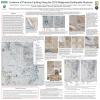Poster #013, Earthquake Geology
Role of confinement in coseismic pulverization of sediments: testing the rock record of rupture directivity on the San Jacinto fault
Poster Image:

Poster Presentation
2020 SCEC Annual Meeting, Poster #013, SCEC Contribution #10311 VIEW PDF
0m. Pulverization has previously been observed as a shallow crustal phenomenon in well-indurated rocks, but the observations in the Bautista Formation sediments prompted Whearty et al. (2017) to propose that a minimum confining pressure may be required to initiate pulverization in unconsolidated to weakly consolidated sediments. Here we test this hypothesis by simulating the pulverization process in Bautista sediments using a modified Split Hopkinson Pressure Bar (SHPB) apparatus. In these experiments, confining pressure is induced on sediments by a cylindrical confining cell in which sediments are packed and plugged on both ends. During experiments in which sediments are compressed axially, a linear strain gauge mounted circumferentially on the outer wall of the cell allows us to calculate the dynamic confining pressure throughout an experiment. Post-mortem experimental samples are used for direct comparison to field samples of damage zone Bautista sediments in order to constrain the natural stress and strain-rate histories. Ultimately, by reproducing microfracture damage fabrics observed in the tonalites and Bautista sediments, we hope to test the hypothesis that the PFZR at Anza Borrego State Park preserve information about long-term preferred rupture directivity on the San Jacinto Fault.
SHOW MORE
SHOW MORE





































